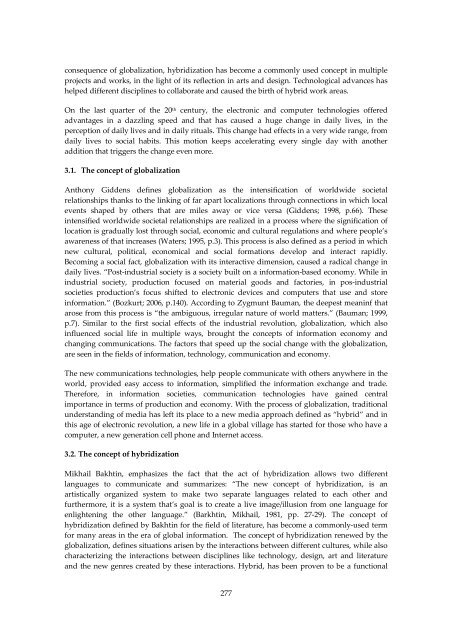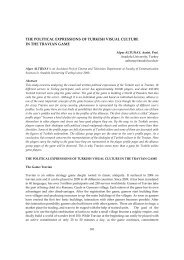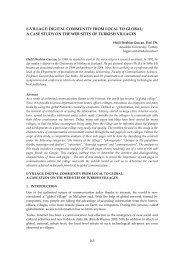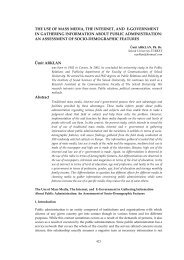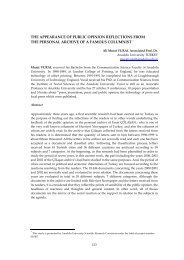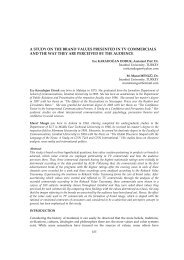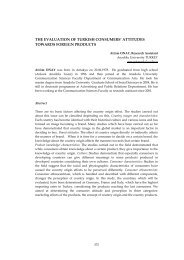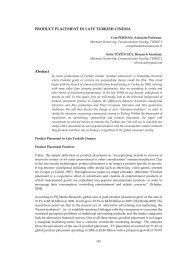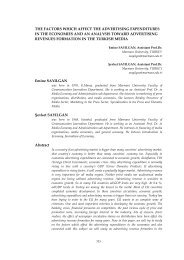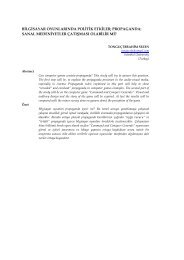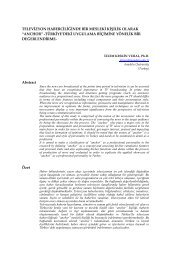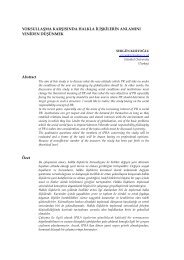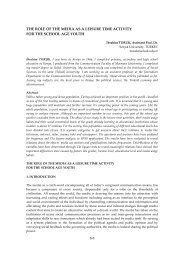an interdisciplinary assay upon internet and social advertising ...
an interdisciplinary assay upon internet and social advertising ...
an interdisciplinary assay upon internet and social advertising ...
Create successful ePaper yourself
Turn your PDF publications into a flip-book with our unique Google optimized e-Paper software.
consequence of globalization, hybridization has become a commonly used concept in multiple<br />
projects <strong>an</strong>d works, in the light of its reflection in arts <strong>an</strong>d design. Technological adv<strong>an</strong>ces has<br />
helped different disciplines to collaborate <strong>an</strong>d caused the birth of hybrid work areas.<br />
On the last quarter of the 20 th century, the electronic <strong>an</strong>d computer technologies offered<br />
adv<strong>an</strong>tages in a dazzling speed <strong>an</strong>d that has caused a huge ch<strong>an</strong>ge in daily lives, in the<br />
perception of daily lives <strong>an</strong>d in daily rituals. This ch<strong>an</strong>ge had effects in a very wide r<strong>an</strong>ge, from<br />
daily lives to <strong>social</strong> habits. This motion keeps accelerating every single day with <strong>an</strong>other<br />
addition that triggers the ch<strong>an</strong>ge even more.<br />
3.1. The concept of globalization<br />
Anthony Giddens defines globalization as the intensification of worldwide societal<br />
relationships th<strong>an</strong>ks to the linking of far apart localizations through connections in which local<br />
events shaped by others that are miles away or vice versa (Giddens; 1998, p.66). These<br />
intensified worldwide societal relationships are realized in a process where the signification of<br />
location is gradually lost through <strong>social</strong>, economic <strong>an</strong>d cultural regulations <strong>an</strong>d where people’s<br />
awareness of that increases (Waters; 1995, p.3). This process is also defined as a period in which<br />
new cultural, political, economical <strong>an</strong>d <strong>social</strong> formations develop <strong>an</strong>d interact rapidly.<br />
Becoming a <strong>social</strong> fact, globalization with its interactive dimension, caused a radical ch<strong>an</strong>ge in<br />
daily lives. “Post-industrial society is a society built on a information-based economy. While in<br />
industrial society, production focused on material goods <strong>an</strong>d factories, in pos-industrial<br />
societies production’s focus shifted to electronic devices <strong>an</strong>d computers that use <strong>an</strong>d store<br />
information.” (Bozkurt; 2006, p.140). According to Zygmunt Baum<strong>an</strong>, the deepest me<strong>an</strong>inf that<br />
arose from this process is “the ambiguous, irregular nature of world matters.” (Baum<strong>an</strong>; 1999,<br />
p.7). Similar to the first <strong>social</strong> effects of the industrial revolution, globalization, which also<br />
influenced <strong>social</strong> life in multiple ways, brought the concepts of information economy <strong>an</strong>d<br />
ch<strong>an</strong>ging communications. The factors that speed up the <strong>social</strong> ch<strong>an</strong>ge with the globalization,<br />
are seen in the fields of information, technology, communication <strong>an</strong>d economy.<br />
The new communications technologies, help people communicate with others <strong>an</strong>ywhere in the<br />
world, provided easy access to information, simplified the information exch<strong>an</strong>ge <strong>an</strong>d trade.<br />
Therefore, in information societies, communication technologies have gained central<br />
import<strong>an</strong>ce in terms of production <strong>an</strong>d economy. With the process of globalization, traditional<br />
underst<strong>an</strong>ding of media has left its place to a new media approach defined as “hybrid” <strong>an</strong>d in<br />
this age of electronic revolution, a new life in a global village has started for those who have a<br />
computer, a new generation cell phone <strong>an</strong>d Internet access.<br />
3.2. The concept of hybridization<br />
Mikhail Bakhtin, emphasizes the fact that the act of hybridization allows two different<br />
l<strong>an</strong>guages to communicate <strong>an</strong>d summarizes: “The new concept of hybridization, is <strong>an</strong><br />
artistically org<strong>an</strong>ized system to make two separate l<strong>an</strong>guages related to each other <strong>an</strong>d<br />
furthermore, it is a system that’s goal is to create a live image/illusion from one l<strong>an</strong>guage for<br />
enlightening the other l<strong>an</strong>guage.” (Barkhtin, Mikhail, 1981, pp. 27-29). The concept of<br />
hybridization defined by Bakhtin for the field of literature, has become a commonly-used term<br />
for m<strong>an</strong>y areas in the era of global information. The concept of hybridization renewed by the<br />
globalization, defines situations arisen by the interactions between different cultures, while also<br />
characterizing the interactions between disciplines like technology, design, art <strong>an</strong>d literature<br />
<strong>an</strong>d the new genres created by these interactions. Hybrid, has been proven to be a functional<br />
277


